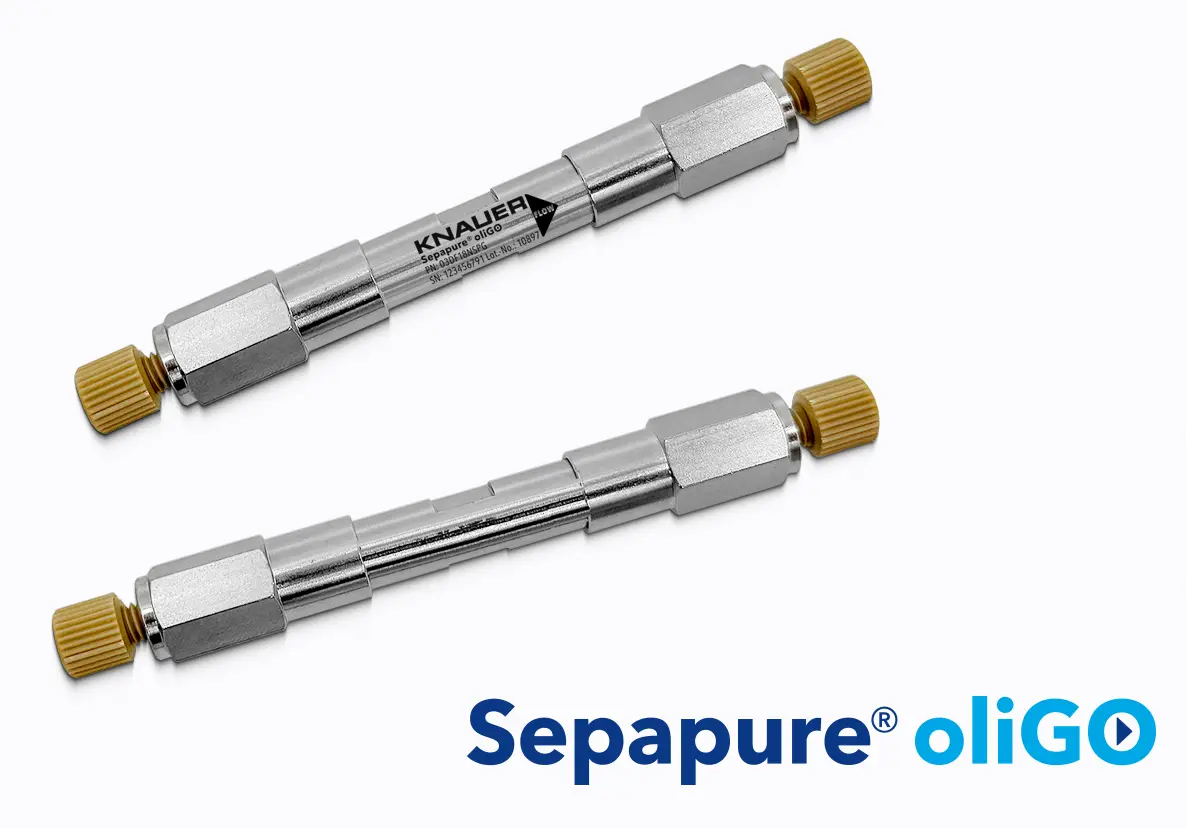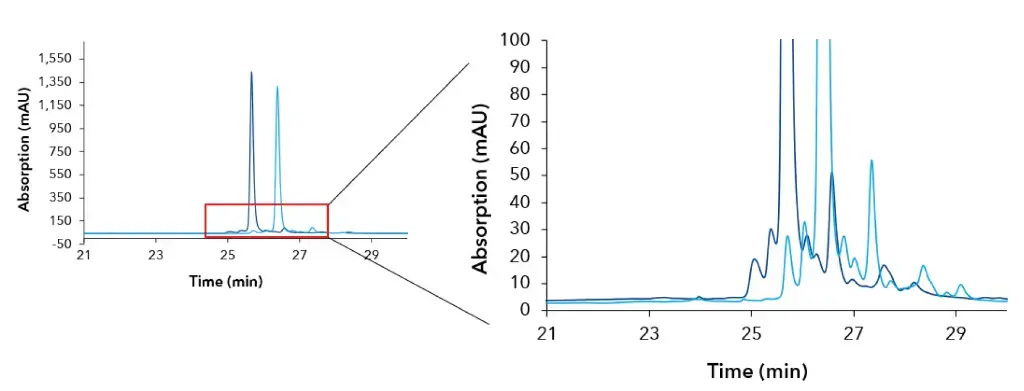A new specialist for oligonucleotides with advantages
Oligonucleotides are the new superstars in medical and biological research, especially when it comes to highly specialized or personalized drugs. More and more drugs are reaching the clinical phase of development or have already been approved by the FDA. The target group is often particularly vulnerable patients, which is why the quality requirements for synthesized oligos and the throughput in analytical laboratories are enormous. The challenge lies in the very long polar chains, which differ only in individual nucleobases or sometimes individual functional groups.
Sepapure oliGO – Why a Dedicated Column?
When it comes to oligonucleotides, it's not always easy to pick the right analytical method. In our blog Oligos Made Easy – Part 6, we give you the lowdown on which separation mechanism is best for your own analysis. Most labs tend to go for IP-RP (ion pairing reversed phase) chromatography because it's really efficient and gets things done quickly. It's also really robust and works well with MS. In Oligos Made Easy - Part 3, we explain exactly how this separation mechanism works optimally. The reagents used are quite strong though and break down the usual RP silica gels. Sepapure oliGO is based on a hybrid silica gel and is also specially capped so that the aggressive IP-RP reagents cannot cause any damage. Also, the functionalization makes sure that there's the best possible RP interaction, as well as ionic interaction. So, when you use Sepapure oliGO in the IP-RP mechanism, it's basically a simple mixed mode column. But it's got a much longer life span than other mixed mode columns. In summary, the Sepapure oliGO is a very robust and perfectly optimized column for the separation of oligos..

Figure 1: Sepapure oliGO columns with laser-etched column information.
Switching Columns? Expect Smooth Sailing.
Our KNAUER application team has joined forces with BianoGMP GmbH to publish an AppNote comparing an established oligo column, which is commonly referenced in scientific publications, with the Sepapure oliGO. BianoGMP GmbH is long experienced in oligonucleotide synthesis and has true experts in oligonucleotides. The AppNote was designed to make it straightforward to transfer the method between the two columns. So, we compared oligonucleotides of different lengths and purity using the IP-RP mechanism. We also used a DNA full thiolate 43mer, paying particular attention to the influence of bioinert hardware. There are mentions in the literature that oligo thiolates interact with ions in stainless steel hardware, resulting in tailing at the peaks for these oligos.
“ The most relevant difference that customers will notice between the two pillars is the significantly lower price of Sepapure oliGO. We have completely switched our routine analysis to Sepapure oliGO. ” – Marvin Schaek, XNApharma GmbH.
Sepapure oliGO versus a publication favorite, how does it perform? The extensive tests can be summarized by stating that, in most cases, direct method transfer is possible without adjustments and only minimal variances are to be expected. While the resolution of both columns was nearly identical, the retention times on the Sepapure oliGO were slightly faster (Figure 2). It is expected that the differences will be even smaller with shorter methods. Furthermore, we were unable to verify the often-acclaimed influence of expensive bioinert hardware in any case. We suspect that this effect could be only relevant for short (U)HPLC methods. However, if you do observe a tailing effect, you can quickly and easily passivate your Sepapure oliGO column yourself and keep your costs down . Please contact us if you have any questions.

Figure 2: Overlayed chromatogram of crude product of a 43mer thiolate oligonucleotide. Light blue - reference column and dark blue – Sepapure oliGO.
How does Sepapure oliGO keep back pressure low for smoother runs?
You can also use the Sepapure oliGO as a (U)HPLC column with fast methods. The low back pressure doesn't cause peak broadening, but it does effectively prevent the typical (U)HPLC disadvantages, like clogging and rapid system wear. We often get feedback from customers that their oligo columns clog quickly or that performance declines after a few months, which is why they're now switching to the Sepapure oliGO with its soft back pressure. This enhances the durability and longevity of the entire HPLC setup.
In our IP-RP separations, we had a back pressure of 200 bar on average with a particle size of 3 µm. This also opens the door for laboratories that do not have an (U)HPLC system but would like to perform highly effective oligonucleotide analysis.
How can you keep your Sepapure oliGO performing at its best?
We suggest to pay attention to the pH and temperature restrictions. But with a recommended range of pH 1.5-10 and 60°C, the column is perfect for all standard applications.
A precolumn can stop coarse synthesis impurities from reaching the main column.
If you observe a constant increase in pressure, you can remove the precolumn and backflush the column at a flow rate of 0.2 mL/min.
If you turn off the flow for a while, like over the weekend, it's really important to rinse out all the salts.
Sepapure oliGO is best stored in a 1:1 mixture of methanol/water or ACN/water (v:v).
It's better to use a gradient when rinsing between standard RP eluents and IP-RP reagents.
Our column care and use supplement includes a regeneration wash cycle for RP columns, which also works very well for the Sepapure oliGO column.
If you've got any questions or need a clarification, just hit up KNAUER's awesome customer support team. We'll answer your questions for free and as
If you want to analyze and purify oligonucleotides, you should switch to the AEX separation mechanism for purification and take a look at our scalable preparative systems. Whatever you need, we've got you covered. Our systems come in all sorts of sizes, from compact and cost-effective to large pilot systems with a flow rate of up to 800 mL/min. And if you need something bioinert, we've got you covered there too. We'll put together a system that's exactly what you require. You can find an example in our blog, Oligos Made Easy _ in Part 7 Large Scale AEX.
If you're planning to set up or optimize your oligonucleotide workflow, feel free to contact us at sales@knauer.net. Stay tuned for more exciting insights into the Oligonucleotide world in our “Oligos Made Easy” series.
For more in-depth discussion or questions,
reach out to the author at folmert@knauer.net

